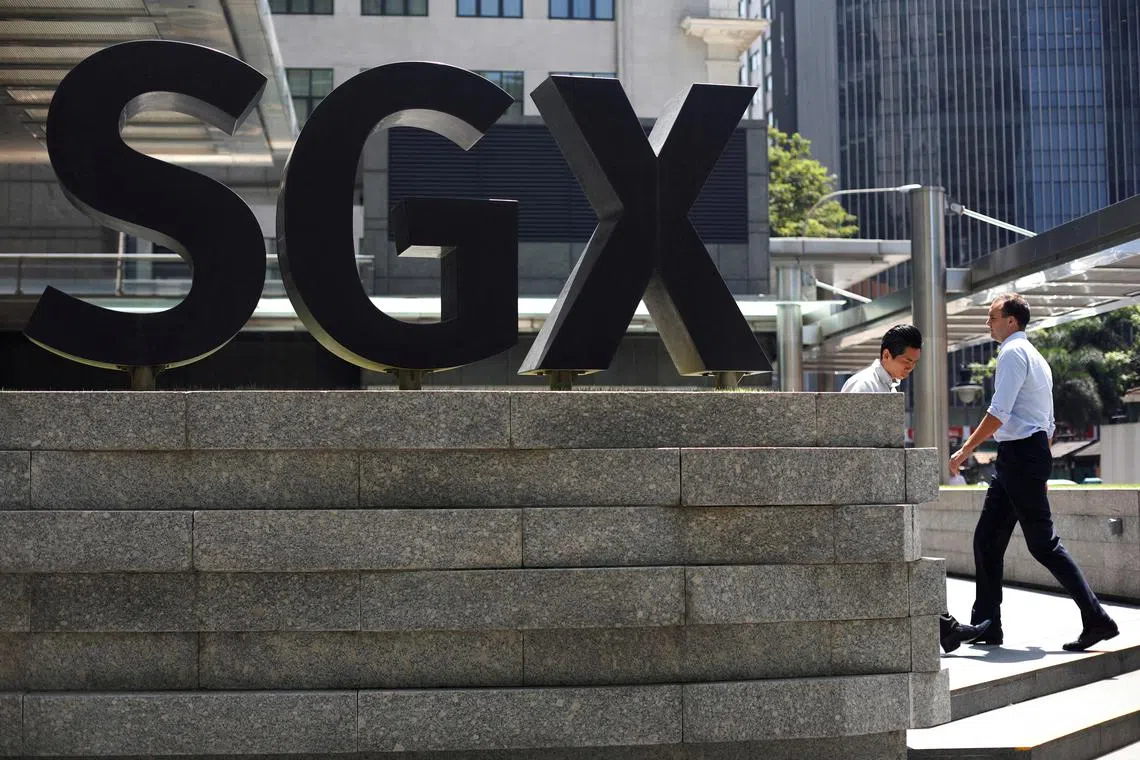Fund managers welcome MAS’ $5b boost for stock market; SGX shares up nearly 4%
Sign up now: Get ST's newsletters delivered to your inbox

SGX shares were trading at $13.22 at noon on Feb 24, up 3.28 per cent, and closed 3.9 per cent higher, at $13.30.
PHOTO: REUTERS
Follow topic:
SINGAPORE – Fund managers welcomed the news of a new $5 billion programme by the Monetary Authority of Singapore (MAS) to boost the Singapore stock market, but said they would still have to look at liquidity and fundamentals, especially those of smaller stocks outside the Straits Times Index.
They added that the move, announced after the market closed on Feb 21, is a step in the right direction.
The Singapore Exchange (SGX) also saw its shares reach a morning high of $13.70 on Feb 24, up from its previous close of $12.80 on Feb 21.
The counter closed 3.9 per cent higher, at $13.30, on Feb 24.
MAS surprised the market when it launched a $5 billion programme
Regulations will also be streamlined to make the listing process more efficient, and to be more focused and facilitative of listings, MAS said.
These were among the first set of measures recommended by the review group set up in August 2024 to strengthen the local stock market.
Mr Lee Kian Soon, chief executive of Astral Asset Management, said the $5 billion programme has attracted some level of interest in the asset management sector, and that fund managers are looking forward to the details of the programme.
He added that as an Asian mid- and small-cap specialist, the company prefers stocks outside the Straits Times Index (STI). He said the MAS programme should have a fixed allocation on stocks outside the STI, as that is the part of the market that is most in need of liquidity.
CGS International analysts Lock Mun Yee and Lim Siew Khee said: “We welcome the liquidity boost and measures to ‘value up’ Singapore equities, and boost shareholder returns.”
They added: “However, we believe liquidity, fundamentals and investible thesis are still key focuses for investors. While we believe small- to mid-cap companies could gain renewed interest, we screen through equities in Singapore based on these criteria: below book valuations, average daily turnover above $1 million, value-up efforts by management, and clear catalysts.”
Azure Capital CEO Terence Wong said the $5 billion fund is an important signal that the Government is willing to give money to fund managers to boost the stock market, even though some say that $5 billion is too small an amount to make an impact.
“It’s about the optics and the signalling,” he said. “If the fund managers really go out to hunt for stocks, this will improve liquidity. There will be investors that will jump on it after the fund managers buy in, or they will think this is interesting, so there is a multiplier effect beyond the $5 billion.”
He added: “You just need something to jolt the ecosystem to improve liquidity and then sometimes the market will take on a life of its own.”
Regarding non-index constituents, Mr Wong said the funds could also be more prescriptively directed to put money into the small- and mid-cap space.
“There are many companies that are seeing ailing valuations but they are good companies which just lack liquidity and interest,” he said.
Mr Neil Synnott, chief commercial officer for Asia at IQ-EQ, noted that a challenge with stocks outside the STI is that they can be more volatile and less liquid, which may increase investment risk.
“The regulatory environment for smaller companies might also be perceived as less favourable, potentially making investments in these stocks less justifiable,” he said.
AGT Partners chief executive Gregory See agreed that the $5 billion programme is a good starting point, although the amount may be modest compared with the overall market capitalisation of the stock market.
“MAS’ actions send a strong signal to the investment community about the Government’s commitment to fostering a robust financial ecosystem through a vibrant stock exchange. Collectively, this initial step could help to attract interest, which should gradually enhance liquidity and stock valuations. This, in turn, could lead to an increase in IPO (initial public offering) listings over time,” he said.
He added that AGT Partners has been actively investing in local equities, with a selective focus on small to mid-caps.
Mr Paul Lee, CEO of Paragon Capital Management, also called the new programme “attractive”, but said the firm has to look at the details before a definitive view can be formed.
He also noted that a fund focused on small to mid-caps could work for the programme.
Shorea Advisors managing director for investments Sin Kuan Cheung said: “If liquidity improves in the small- (and) mid-cap stocks, there would be more interest. More up-and-coming businesses will choose to list on the SGX, thereby expanding the investable universe.”
Mr Shane Chesson, founding partner of Openspace, a venture capital and growth stage fund manager, emphasised that the programme aims to support a broader range of companies so they see a boost in liquidity and awareness.
“This may well include small- and mid-cap existing stocks, but we believe that a big part of the emphasis should be on new entrant IPOs that have the size, financial profile, sectoral exposure, brand awareness and governance strength to create new excitement on the exchange and a new class of new economy growth stocks,” he said.
“This will have spillover benefits to all stocks listed but, naturally, highest attention should be on those that are performing and exciting to own for short- or long-term returns.”
Mr Chesson, who is also vice-chairman of the Singapore Venture and Private Capital Association, said that an example of a fund strategy that could be under this programme can be one that gets to know pre-IPO companies and invest in them.
He noted that the full details of the programme like incentives and investment constraints are still pending, but he expects many market participants to think about how they can value-add in the scheme and consider applying.
“We have a lot of global fund managers based in Singapore who have Asia programmes that could redeploy and boost,” he said. He added that there are also private market players who know the existing landscape and will add public market and IPO subscription capability.
Sue-Ann Tan is a business correspondent at The Straits Times covering capital markets and sustainable finance.


